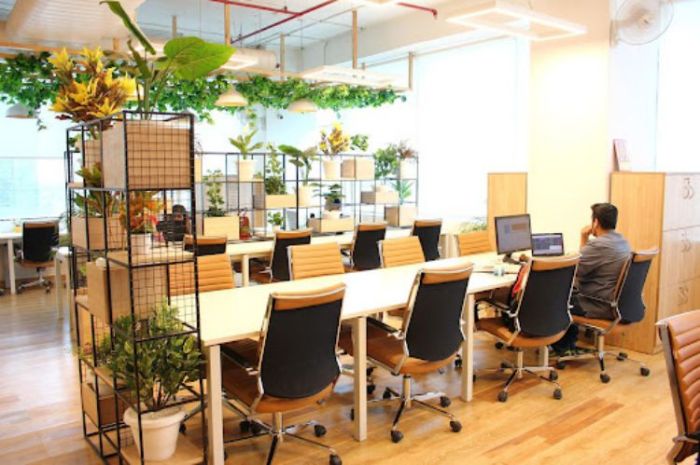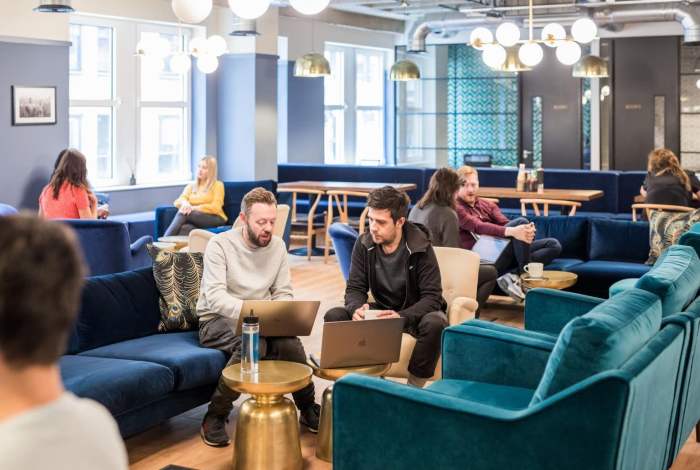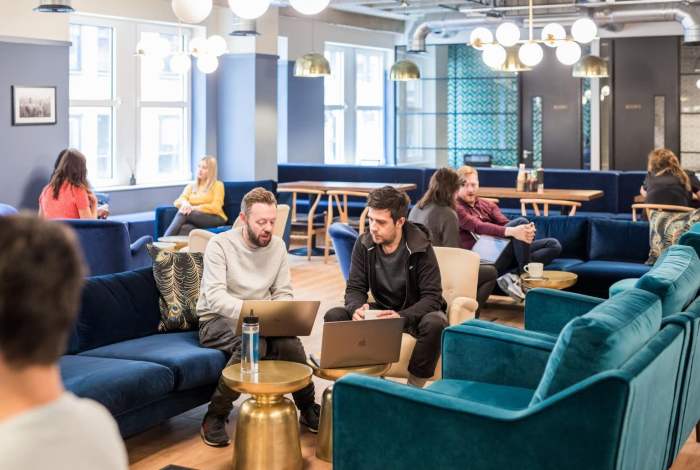This is what the future of coworking should look like: a dynamic ecosystem where work, community, and well-being seamlessly intertwine. As the traditional office landscape evolves, coworking spaces are poised to become the hubs of innovation, fostering collaboration and adaptability in the face of changing work trends.
From remote work and the gig economy to automation and sustainability, the future of work is being reshaped by a confluence of forces. Coworking spaces, with their inherent flexibility and focus on community, are uniquely positioned to navigate these changes and become the go-to spaces for individuals and businesses alike.
The Evolution of Coworking

The coworking movement has experienced a remarkable journey, transforming from a niche concept into a global phenomenon. Its origins can be traced back to the early 2000s, fueled by the rise of the internet and the growing demand for flexible and collaborative workspaces.
The early coworking spaces provided a haven for freelancers, entrepreneurs, and remote workers seeking a sense of community and shared resources. However, as the concept gained momentum, it evolved to cater to a broader range of individuals and businesses, offering a more diverse set of amenities and services.
Coworking’s Departure from Traditional Office Spaces
Coworking spaces have fundamentally shifted the traditional office paradigm. They offer a stark contrast to the rigid and hierarchical structures of conventional workplaces, embracing a more fluid and collaborative environment. Unlike traditional offices, which often emphasize individual cubicles and limited interaction, coworking spaces prioritize open layouts, shared work areas, and communal spaces designed to foster interaction and collaboration.
This shift in design philosophy reflects the evolving needs of the modern workforce, which increasingly values flexibility, connection, and a sense of community. The traditional office environment, with its emphasis on individual productivity, often felt isolating and lacked the social and collaborative aspects that coworking spaces readily provide.
Adapting to Changing Needs and Trends
The coworking industry has proven remarkably adept at adapting to changing needs and trends. As the industry matured, coworking spaces diversified their offerings, catering to specific demographics and industries. This evolution has been driven by a combination of factors, including the rise of remote work, the increasing demand for flexible work arrangements, and the growing importance of community and collaboration.
Browse the implementation of online accounts could be verified using indian governments unique id project aadhaar in real-world situations to understand its applications.
- Specialized Workspaces:Coworking spaces have emerged to cater to specific industries, such as technology, healthcare, and creative arts. These spaces offer specialized amenities and services tailored to the unique needs of their target audiences. For instance, technology-focused coworking spaces might provide access to high-speed internet, networking events, and mentorship programs for startups.
- Hybrid Work Models:The rise of hybrid work models has led coworking spaces to adapt their offerings to accommodate the needs of employees working both remotely and in the office. Some spaces provide dedicated desks for regular use, while others offer flexible membership options that allow individuals to access coworking facilities on an as-needed basis.
This flexibility has proven particularly attractive to companies seeking to provide their employees with the best of both worlds – the flexibility of remote work combined with the benefits of a collaborative and professional work environment.
- Focus on Wellbeing:In response to the growing emphasis on employee wellbeing, coworking spaces have incorporated wellness amenities and programs into their offerings. This includes providing access to fitness centers, yoga studios, meditation rooms, and healthy food options. By prioritizing employee wellbeing, coworking spaces are creating a more holistic and supportive work environment that can enhance employee productivity and satisfaction.
The Future of Work

The future of work is being reshaped by a confluence of technological advancements, societal shifts, and evolving workforce expectations. The traditional office environment is facing significant disruption as remote work, the gig economy, and automation become increasingly prevalent. Coworking spaces, with their inherent flexibility and adaptability, are well-positioned to navigate these changes and become a cornerstone of the future of work.
The Rise of Remote Work
Remote work is no longer a fringe concept but a mainstream reality. The COVID-19 pandemic accelerated this trend, demonstrating that productivity and collaboration can thrive in distributed settings. This shift has profound implications for the traditional office environment. Companies are rethinking their real estate strategies, opting for smaller, more flexible workspaces or embracing fully remote models.
- Increased Flexibility and Work-Life Balance:Remote work offers employees greater flexibility in managing their schedules and integrating work with personal life, leading to improved work-life balance and potentially increased productivity.
- Expanded Talent Pool:Companies can access a broader pool of talent, regardless of geographic location, allowing them to hire the best individuals for the job, regardless of where they reside.
- Reduced Costs:Remote work can lead to cost savings for businesses, including reduced overhead costs associated with office space, utilities, and commuting.
The Growth of the Gig Economy
The gig economy, characterized by short-term, project-based work arrangements, is rapidly expanding. This trend is driven by factors such as the desire for greater flexibility, the rise of digital platforms connecting workers with opportunities, and the increasing demand for specialized skills.
- Flexibility and Independence:Gig workers enjoy the freedom to choose their projects, set their own hours, and work independently, providing a high level of autonomy and control over their work lives.
- Skill-Based Opportunities:The gig economy offers opportunities for individuals to leverage their specialized skills and knowledge, enabling them to find work that aligns with their expertise and interests.
- Increased Demand for Specialized Skills:The growth of the gig economy is fueling demand for specialized skills in areas such as technology, marketing, and creative services, driving the need for continuous learning and skill development.
The Impact of Automation
Automation is transforming various industries, automating tasks that were previously performed by humans. While this trend can lead to job displacement in certain sectors, it also creates new opportunities in areas such as data analysis, artificial intelligence, and robotics.
- Increased Efficiency and Productivity:Automation can streamline processes, improve efficiency, and boost productivity by automating repetitive tasks, allowing human workers to focus on more complex and creative endeavors.
- New Job Opportunities:While automation may displace some jobs, it also creates new opportunities in areas related to the development, implementation, and maintenance of automated systems.
- Shifting Skill Requirements:Automation necessitates a shift in skill requirements, emphasizing adaptability, problem-solving, and critical thinking skills.
Designing the Ideal Coworking Space: This Is What The Future Of Coworking Should Look Like
The future of coworking goes beyond just providing a shared workspace. It’s about creating a dynamic ecosystem that fosters collaboration, innovation, and well-being. To achieve this, we need to rethink the design of coworking spaces, incorporating functionality, design, and technology in a way that caters to the evolving needs of the modern workforce.
Key Features of an Ideal Coworking Space
Designing a future-proof coworking space requires a holistic approach, considering the needs of diverse users and the changing landscape of work. Here’s a breakdown of key features:
| Feature | Description | Benefits |
|---|---|---|
| Flexible and Adaptable Layout | The space should be designed to accommodate different work styles and activities, with easily reconfigurable furniture and modular walls. This allows for a seamless transition between collaborative, focused, and social areas. | Promotes a sense of dynamism and caters to the diverse needs of members, enhancing productivity and engagement. |
| Technology Integration | Seamless integration of technology is crucial for efficient communication, collaboration, and productivity. This includes high-speed internet, video conferencing facilities, and smart meeting rooms. | Streamlines workflows, fosters remote collaboration, and enhances the overall user experience. |
| Sustainable Design | The space should prioritize sustainability by incorporating energy-efficient lighting, water-saving fixtures, and recycled materials. This aligns with the growing focus on environmental responsibility. | Reduces the environmental impact, promotes a sense of social responsibility, and attracts environmentally conscious members. |
| Community Building Features | Dedicated spaces for networking, events, and social gatherings foster a sense of community and encourage interaction among members. | Enhances the overall coworking experience, facilitates knowledge sharing, and promotes a sense of belonging. |
| Well-being Amenities | Access to wellness amenities such as fitness centers, meditation rooms, and outdoor spaces promotes physical and mental well-being, contributing to a healthier and more productive environment. | Reduces stress, improves focus, and enhances overall well-being, leading to increased productivity and job satisfaction. |
Designing for Different Work Styles
An ideal coworking space should cater to various work styles, providing dedicated areas for:
Collaborative Work
- Open-plan areas with comfortable seating, whiteboards, and collaborative tools for brainstorming and team projects.
- Meeting rooms of various sizes equipped with video conferencing and presentation technology for team meetings and client interactions.
- Informal gathering spaces for casual discussions and networking.
Focused Work
- Quiet zones with individual workspaces, sound-absorbing materials, and minimal distractions for focused tasks.
- Private phone booths for confidential calls and video conferences.
- Dedicated spaces for individual work, such as libraries or reading rooms.
Social Work
- Common areas with comfortable seating, coffee bars, and social activities to encourage networking and community building.
- Outdoor spaces for relaxation, fresh air, and informal meetings.
- Event spaces for workshops, talks, and social gatherings to foster a sense of community and engagement.
Community and Collaboration in the Future of Coworking
The future of coworking is not just about physical spaces; it’s about fostering a vibrant community that fuels innovation and collaboration. The best coworking spaces go beyond offering desks and internet access, creating environments where members can connect, learn, and grow together.
Building a Strong Community
A strong community within a coworking space is crucial for its success. It fosters a sense of belonging, encourages knowledge sharing, and provides a platform for members to support each other.
- Regular Social Events:Organizing social gatherings like happy hours, workshops, or themed events can help members connect outside of work and build relationships.
- Member Profiles and Networking Tools:Providing online platforms where members can create profiles, share their expertise, and connect with others based on shared interests or projects.
- Community Management:A dedicated community manager can play a vital role in fostering a sense of belonging, resolving conflicts, and promoting member engagement.
Strategies for Fostering Collaboration
Collaboration is at the heart of a thriving coworking community. Strategies that encourage interaction and knowledge sharing are key.
- Dedicated Collaboration Spaces:Designing spaces specifically for group work, brainstorming sessions, or team meetings encourages interaction and teamwork.
- Cross-Pollination Initiatives:Organizing events where members from different industries or disciplines can interact and share their insights can lead to unexpected collaborations.
- Mentorship Programs:Pairing experienced members with those who are new to the space or starting their own ventures can create valuable mentorship opportunities.
Examples of Successful Community-Building Initiatives, This is what the future of coworking should look like
Many coworking spaces have implemented successful initiatives to build strong communities.
- WeWork:WeWork’s “Community Manager” program focuses on building relationships with members and organizing events that foster a sense of belonging.
- The Hub:The Hub in London offers a variety of workshops, networking events, and social activities to encourage collaboration and connection among members.
- Impact Hub:Impact Hub, with locations worldwide, focuses on creating spaces for social entrepreneurs and impact-driven businesses to connect and collaborate on projects that address global challenges.
Sustainability and Wellbeing in Coworking
The future of coworking is not just about providing a flexible workspace; it’s about creating a sustainable and healthy environment that fosters well-being and productivity. Integrating sustainability practices and prioritizing mental health are crucial for attracting and retaining members in the long run.
Sustainable Coworking Spaces
Sustainability is becoming increasingly important for businesses and individuals alike. Coworking spaces can play a significant role in promoting sustainable practices by implementing eco-friendly solutions in their operations.
- Energy Efficiency:Implementing energy-efficient lighting, HVAC systems, and appliances can significantly reduce energy consumption. This can include using LED lighting, smart thermostats, and energy-efficient appliances.
- Waste Reduction and Recycling:Encouraging members to recycle and compost is essential. Coworking spaces can provide designated recycling bins and composting facilities. They can also implement policies to reduce single-use plastics and paper consumption.
- Water Conservation:Installing low-flow faucets and toilets, and promoting water-saving practices among members can contribute to water conservation. Utilizing rainwater harvesting systems can also be a sustainable solution.
- Green Building Materials:Using sustainable building materials such as bamboo, recycled materials, and locally sourced wood can reduce the environmental impact of the space. This can also create a more natural and welcoming environment for members.
- Sustainable Transportation:Encouraging members to use public transportation, cycling, or walking to work can reduce carbon emissions. Coworking spaces can provide bike racks and shower facilities to promote sustainable commuting.
Promoting Wellbeing and Mental Health
Coworking spaces can contribute to the well-being of their members by creating a positive and supportive environment.
- Ergonomic Workspaces:Providing ergonomic furniture, adjustable desks, and proper lighting can help prevent physical discomfort and promote healthy posture.
- Mental Health Resources:Offering access to mental health resources, such as meditation apps, mindfulness programs, and counseling services, can help members manage stress and improve their overall well-being.
- Healthy Food and Beverages:Providing healthy food and beverage options can promote healthy eating habits and contribute to overall well-being. This can include offering fresh fruit, vegetables, and water, and limiting the availability of unhealthy snacks and sugary drinks.
- Socialization and Community Building:Creating opportunities for members to connect and socialize can reduce feelings of isolation and promote a sense of community. This can include hosting networking events, workshops, and social gatherings.
- Quiet Zones and Collaboration Spaces:Providing dedicated quiet zones for focused work and collaborative spaces for team projects can cater to different work styles and preferences.
Innovative Solutions for a Sustainable and Healthy Work Environment
- Living Walls:Installing living walls with plants can improve air quality, reduce noise pollution, and create a more natural and calming environment.
- Biophilic Design:Incorporating elements of nature, such as natural light, plants, and organic materials, can create a more stimulating and relaxing work environment. This can reduce stress and improve focus.
- Smart Technology:Utilizing smart technology, such as sensors for lighting and HVAC systems, can optimize energy efficiency and create a more comfortable work environment.
- Shared Resources:Encouraging members to share resources, such as printers, scanners, and meeting rooms, can reduce waste and promote a sense of community.
- Community Gardens:Creating a shared community garden can provide members with an opportunity to connect with nature, grow their own food, and promote a sense of sustainability.
Technology and Innovation in Coworking

The future of coworking is intertwined with the adoption of emerging technologies that enhance the experience for members and streamline operations. These technologies are not just about adding gadgets; they are about creating a more connected, efficient, and personalized workspace.
The Role of Technology in Coworking Space Design
Technology is transforming the way coworking spaces are designed. The focus is shifting from traditional office layouts to dynamic, flexible, and tech-enabled environments.
- Smart Building Technology:Coworking spaces are increasingly integrating smart building technologies such as sensors, AI-powered systems, and automation to optimize energy efficiency, improve environmental control, and enhance security. For instance, sensors can detect occupancy levels and adjust lighting and temperature accordingly, reducing energy consumption and creating a more comfortable environment.
- Interactive Displays and Digital Signage:Interactive displays and digital signage are becoming essential for wayfinding, communication, and engagement. These displays can provide real-time information on available meeting rooms, event schedules, and even community updates. They can also be used to showcase member profiles, highlight success stories, and create a more dynamic and engaging atmosphere.
- Biophilic Design:Incorporating biophilic elements, such as living walls, green spaces, and natural light, into coworking spaces can improve air quality, reduce stress, and enhance well-being. Smart technology can play a role in optimizing these elements, such as using sensors to monitor air quality and adjust ventilation systems accordingly.
Technology for Collaboration and Communication
Technology is bridging the gap between physical and virtual work environments, enabling seamless collaboration and communication within coworking spaces.
- Video Conferencing and Virtual Meeting Rooms:High-quality video conferencing systems are essential for remote teams to connect and collaborate effectively. Coworking spaces are investing in dedicated virtual meeting rooms with advanced audio and video capabilities, ensuring seamless communication and a professional experience.
- Collaboration Platforms:Cloud-based collaboration platforms, such as Slack, Microsoft Teams, and Google Workspace, are essential for communication, file sharing, and project management. Coworking spaces can provide access to these platforms and integrate them into their infrastructure to facilitate collaboration among members.
- Digital Whiteboards and Interactive Displays:Interactive displays and digital whiteboards allow teams to brainstorm, collaborate, and share ideas in real-time. These technologies enhance productivity and creativity by enabling seamless idea capture and sharing.
Technology for Productivity and Efficiency
Technology is empowering members to work more productively and efficiently within coworking spaces.
- Desk Booking Systems:Coworking spaces are utilizing desk booking systems that allow members to reserve desks and meeting rooms in advance, ensuring a smooth and efficient workflow. These systems also provide valuable data on space utilization, enabling operators to optimize space allocation and member experience.
- Access Control and Security Systems:Smart access control systems, using keycards, mobile apps, or facial recognition, enhance security and provide members with convenient access to the space. These systems also allow operators to track member activity and ensure a safe and secure environment.
- Personalized Workspace Settings:Technology can enable members to personalize their workspace settings, such as lighting, temperature, and desk configurations, to create a more comfortable and productive environment.



